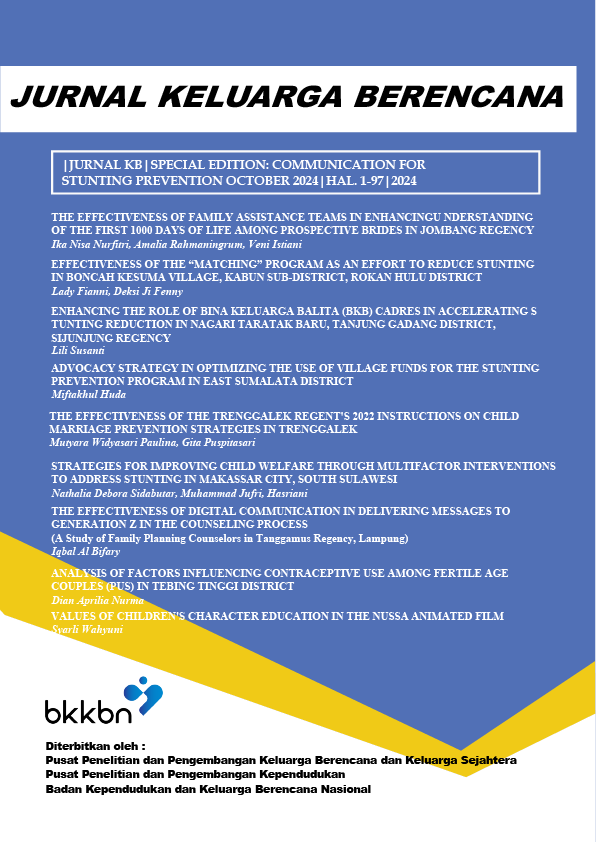ANALYSIS OF FACTORS INFLUENCING CONTRACEPTIVE USE AMONG FERTILE AGE COUPLES (PUS) IN TEBING TINGGI DISTRICT
DOI:
https://doi.org/10.37306/2mbsc574Keywords:
Husband’s support, Contraception, couples of reproductive ageAbstract
An increase in the Total Fertility Rate (TFR) leads to a growing population and a decline in family quality within a society. This study aims to identify the factors influencing contraceptive use among couples of reproductive age in Tebing Tinggi District. A cross-sectional design was employed, with multivariate analysis used for prediction models. The sample consisted of couples of reproductive age in Tebing Tinggi District, West Tanjung Jabung Regency, selected through a simple random sampling method. Six variables were found to be significantly associated with contraceptive use: husband’s support, knowledge, education, partner’s attitude, perception of side effects, and sources of information. Conversely, there was no significant relationship between the ideal number of children, economic status, and cultural factors with contraceptive use. The dominant factor influencing contraceptive use was husband’s support, showing a higher likelihood of contraceptive use among couples who received support from their husbands. Health facilities play a crucial role as pioneers in providing education to couples of reproductive age regarding contraceptive use, thus potentially increasing participation in family planning programs among these couples.
Downloads
References
Aprillia YT, Adawiyah AR and Agustina S. (2020). Analysis of Contraceptive Use Before and During the Covid-19 Pandemic. Journal for Healthy Society (JUKMAS), 4(2): 190–200.
Ariani, E. (2014). 'Factors Influencing Contraceptive Choices at Pleret Bantul Health Center in 2012'.
Bernadus, J. D., Madianung, A., & Masi, G. (2013). Faktor-faktor yang berhubungan dengan pemilihan alat kontrasepsi dalam rahim (AKDR) bagi akseptor KB di Puskesmas Jailolo. e-NERS, 1(1). https://doi.org/10.35790/ens.v1i1.1760
BKKBN. (2015). Kualitas Sumber Daya Manusia Dalam Menggapai Bonus Demografi. Buletin Jendela Data dan Informasi Kesehatan, 2(1), 102–114. https://pusdatin.kemkes.go.id/download.php?file=download/pusdatin/buletin/ buletin-kespro.pdf
BKKBN. (2016). 'Number of Family Planning Participants Coverage. Government Agency Performance Report 2015 National Population and Family Planning Agency'.
BKKBN. (2021). '2021 Indonesian Family Data Collection'.
Central Statistics Agency. (2022). Statistics Indonesia Releases 2020 Census Results. https://setkab.go.id/en/statistics-indonesia-releases-2020-census-results/
Hasanah, N. U. (2014). Hubungan dukungan sosial suami dengan kecenderungan baby blues syndrome pada ibu pasca melahirkan: Studi kasus di Rumah Sakit Umum Daerah dan Bidan Pelayanan Swasta Nurlaila di Sigli (Doctoral dissertation, Universitas Islan Negeri Maulana Malik Ibrahim). http://etheses.uin-malang.ac.id/613/
Dalimawaty, K. (2021) 'Factors Influencing Mothers' Interest in Using IUD Contraceptives' in Health Center Binjai Estate', Journal Scientific Midwifery Indonesia, 4(4): 519. Available at: https://journals.stikim.ac.id/index.php/jiki/article/view/727.
Jurisman, A., Ariadi, A. and Kurniati, R. (2016). 'The Relationship between Maternal Characteristics and Contraceptive Choices at Padang Pasir Padang Health Center', Andalas Health Journal, 5(1): 191–195. doi: 10.25077/jka.v5i1.467.
Kasim, J., Muchtar, A. (2019). 'Use of IUD Contraceptives on Sexuality in Fertile Couples in the Work Area of the Pallangga Health Center, Gowa Regency', Health Media, Makassar Health Polytechnic, 14(2): 1689–1699. Available at: www.journal.uta45jakarta.ac.id.
Kunang, A. (2016). Faktor- faktor yang berhubungan dengan penggunaan alat kontrasepsi iud pada akseptor kb di wilayah kerja Puskesmas Tanjung Kemala Kabupaten Tanggamus. Jurnal Ilmiah Kesehatan, 5(10). https://doi.org/10.52657/jik.v5i10.1130
Listyaningsih, U. and Satiti, S. (2022). 'Fertility dynamics and contraceptive prevalence in Indonesia', Indonesian Journal of Population, 16(2): 153. doi: 10.14203/jki.v16i2.595.
Maika, A., Kuntohadi, W. (2019). Penggunaan Kontrasepsi Pasca Melahirkan, Jakarta: BKKBN.
Notoatmodjo, S. (2012). Promosi Kesehatan dan Perilaku Kesehatan. Jakarta: PT Rineka Cipta.
Pembajeng GS, Azalea KZ, Indonesia U of and Chrisiavinta K. (2020). Planning and Evaluation of Family Planning Programs during the COVID-19 Pandemic. 3(1): 29–35. Available at: https://www.researchgate.net/publication/348049736_PLANNING_AND_EVALUATION_OF_FAMITAL_PLANNING_PROGRAMS_DURING_THE_COVID-19_PANDEMIC .
Pinamangun, W., Kundre, R., Bataha, Y., Keperawatan, I., & Kedokteran, F. (2018). Hubungan dukungan suami dengan pemilihan jenis kontrasepsi Intra Uterine Device pada wanita usia subur di Puskesmas Makalehi Kecamatan Siau Barat. Jurnal Keperawatan, 6(2), 1-7. https://ejournal.unsrat.ac.id/index.php/jkp/article/download/20648/20263
Putri, M. D. A., & Adriyani, R. (2018). Hubungan usia balita dan sanitasi fisik rumah dengan kejadian ISPA di Desa Tumapel Kabupaten Mojokerto tahun 2017. The Indonesian Journal of Public Health, 13(1), 95-106. https://doi.org/10.20473/ijph.v13i1.2018.98-109
Putri, S. F., Sausan, S., Putri, A. N., & Agustina, F. A. (2021). Analisis Penggunaan Alat Kontrasepsi di Masa Pandemi Covid-19. Jurnal Kesehatan Tambusai, 2(2), 71-79. https://www.academia.edu/download/103240883/pdf.pdf
Rowslands. (2014). 'Contraceptive Implants : Current Perspective', Journal of Contraception, 5: 73–84.
Salsabilla, B., Nasution, A. and Avianty, I. (2018). 'Factors Related to the Selection of Intra-Uterine Device (IUD) Contraceptives in Fertile Age Couples in Sempur Village, Bogor Tengah District, Bogor City in 2018', Promotor of Public Health Student Journal, 1(1): 8–14.
Setiasih, S., Widjanarko, B., & Istiarti, T. (2016). Analisis faktor-faktor yang mempengaruhi pemilihan metode kontrasepsi jangka panjang (MKIP) pada wanita pasangan usia subur (PUS) di Kabupaten Kendal tahun 2013. Jurnal Promosi Kesehatan Indonesia, 11(2), 32-46. https://doi.org/10.14710/jpki.11.2.32-46
Setiyani, MS. (2020). 'Relationship between Risk Factors and IUD Drop Out in Kademangaran Village' Subdistrict Dukuhturi Regency Tegal Year 2019', 8: 1–9.
Soekanto, S. 2006. Sosiologi Suatu Pengantar. Jakarta: Raja Grafindo Persada.
Supriadi. (2017). Faktor yang Berhubungan dengan Penggunaan Alat Kontrasepsi Pada Pasangan Usia Subur di Wilayah Kerja Puskesmas Kapasa. Skripsi. Dep. Biostatistik, Fakultas Kesehatan Masyarakat, Universitas Hasanuddin Makassar.
Suyati, S. (2013). Pengaruh Dukungan Suami terhadap Ketepatan Kunjungan Ulang Akseptor Kb Suntik. STRADA Jurnal Ilmiah Kesehatan, 2(2), 62-68. https://sjik.org/index.php/sjik/article/view/56
Syahban, B. F., Fauziah, & Rahmawati. (2018). Status sosial ekonomi dengan penggunaan KB implan pada wanita PUS di wilayah kerja Puskesmas Loa Buah tahun 2017. Bunda Edu-Midwifery Journal, 1(1), 19–22. https://bemj.e-journal.id/BEMJ/article/view/14
[WHO] World Health Organization. (2019). 'Modern Contraceptive Use.
Downloads
Published
Issue
Section
License
Copyright (c) 2024 Dian Aprilia Nurma Dian

This work is licensed under a Creative Commons Attribution-NonCommercial-ShareAlike 4.0 International License.
Deprecated: json_decode(): Passing null to parameter #1 ($json) of type string is deprecated in /var/www/html/ejurnal/plugins/generic/citations/CitationsPlugin.php on line 68







